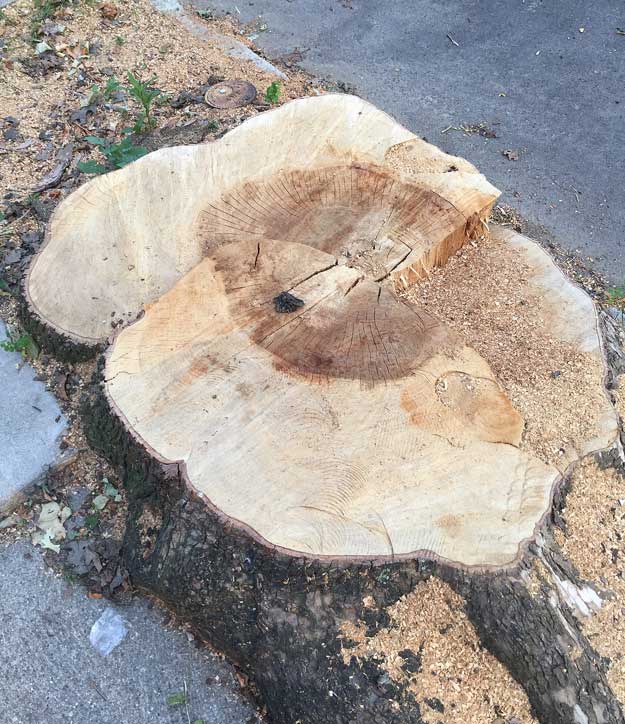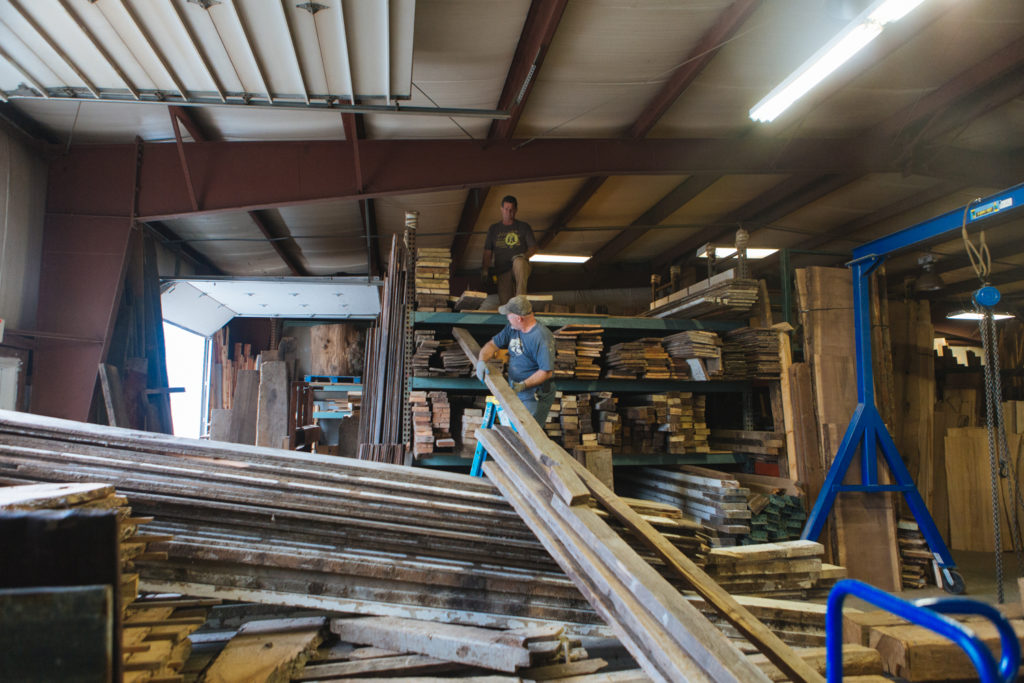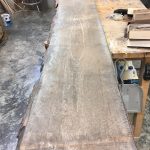We may receive a commission when you use our affiliate links. However, this does not impact our recommendations.

One of many stumps currently in Cincinnati’s Northside neighborhood; urban forestry is working with a regional sawyer to mill and kiln-dry wood suitable for furniture use.
Recently in my neighborhood, there has been an alarming outbreak of stumps. The City of Cincinnati has been removing trees that are encroaching on and breaking up the sidewalks, in anticipation of the replacement and repair of said walkways – a cost that is the responsibility of homeowners…which has caused some anger.
I understand why we need passable walkways (I also understand the disgruntlement at having to pay for them, particularly with little notice) – but the woodworker and dendrophile in me is most alarmed by the loss of many mature shade trees in my neighborhood.
So I called Cincinnati Parks and talked with urban forester Kurt Kastner, who says the city is working with Ohio Wood Connection (up I-75 in Monroe, Ohio) to save the wood deemed suitable for furniture and other building projects. Most of the trees being felled right now are Zelkova serrata planted in the early 1980s (though there are some other species mixed in). It’s a vase-shaped Japanese species that is tolerant of drought and air pollution, that looks similar to elm (and if the size of the stumps speak true, it is also pretty fast-growing). While it has a long history as a furniture species in Asia, I’ve never had the opportunity to work with it. But, says Kastner, many of the boles (the trunks) are rotted or too twisted to be suitable for sawing.
They are, however, being hauled to a city-owned site on the east side of town, and there, Marcus Grooms, of Ohio Wood Connection in Mason, Ohio, selects logs he thinks can be milled and kiln-dried for use. “For me to clean some of it up is just good stewardship,” says Grooms.
“Everything that it is in my shop is locally harvested,” says Grooms. “I gave a good idea of where these logs are from; I’ve handled them enough that I know the story and I try to relay that to people.”
Much of the city wood Grooms mills and dries in his vacuum kiln is ash, because lots of ash trees are being felled in attempts to combat the Emerald ash borer. He also gets elm, spalted maple, cherry and pin oak, which Grooms notes is not ideal for lumber, but in slab form can be put to good use.
“It makes me sick to my stomach to see the number of trees that are chucked into the landfill,” says Grooms. “There’s a higher use for it.”

Marcus Grooms (top) and Jason Albright with just some of the lumber at Ohio Wood Connection (which also offers wood reclaimed from barns and other buildings). Photo by David Lyell.
Not all urban lumber is suitable for use, of course – but there are outfits throughout the country doing their best to identify what can be milled and dried.
Roger Benton, co-owner of Re-Co BKLYN, says his Brooklyn-based company harvests around 200 trees every year from New York City and the surrounding areas. As in Cincinnati, not all the trees lend themselves to furniture use. “We look for hardwood species that are rot free and relatively straight-standing with little lean or twist,” says Roger. “We will typically use straighter logs for dimensional boards and larger logs or those with a lot of shape for live edge slabs.”
And then there’s the challenge of bringing down a tree in a densely populated area. Benton says there’s a huge difference between tree removal and tree harvesting. “In the urban setting, without the open space necessary to let a tree simply fall, common practice is to cut the tree from the top down, taking smallish chunks at a time and carting them away to be ground up and dumped,” he says. “We have to work closely with tree services when harvesting a tree in order to make sure they keep the notch and back cuts as low as possible and leave as much length on the trunk as possible. This can often mean using a crane to hold the weight of a trunk while it is cut loose from the stump.”
And after doing this for years, Benton has gotten pretty good at judging which logs are going to dry and mill with little trouble, “but it’s all been lessons learned the hard way,” he says.
Though it is more difficult to harvest lumber from cities than from forests, it’s worth the time to look for such stock– not only are you keeping it out of the landfill, there’s a story to go with your completed project. So I’m taking a trip up to Ohio Wood Connection, to see if I can find some Northside lumber to make into a project in my Northside home.Below are some resources for urban lumber in various areas of the country – and I know there are more. So please leave comments with sources in your area.
Below are some resources for urban lumber in various areas of the country – and I know there are more. So please leave comments with sources in your area.
And finally, for more on urban lumber, watch the videos below from David Barmon of Fiddlehead Landscapes near Portland, Ore.; he’s a passionate voice for urban lumber and sustainability, and is working on a book on the “current state of urban forestry and the massive waste of wood fiber, as well as retooling our urban forests to plan for the future with urban lumber in mind,” he says. The rough draft should be done in early 2018 – I, for one, am looking forward to reading it.
Angel City Lumber, Los Angeles
Re-Co BYLYN, Brooklyn, NY
Horigan Urban Products, Chicago
Ohio Wood Connection, Mason, Ohio
Urbn Timber, Columbus, Ohio
The Urban Lumber Company, Kansas City, Missouri
Wisconsin Urban Wood, various outlets in Wisconsin
Indy Urban Hardwood, Indianapolis
Urban Timers, central Arkansas
Sacramento Tree Foundation Urban Wood Project, Sacramento, Calif.
Here are some supplies and tools we find essential in our everyday work around the shop. We may receive a commission from sales referred by our links; however, we have carefully selected these products for their usefulness and quality.









I have milled a few trees with a chainsaw. A Garrett pinpointer is used to scan the trunk before making a rip, and again before each slab is ripped. Use the same tool on used lumber. Saves a lot of blades. I have a metal detector but have not used it on trees. The pinpointer does not identify what kind of metal, but who cares. It will all damage blades. Also watch for blue stains. They will move upward from where nails were driven into trees.
Trying to turn urban lumber making into an outlet for graduates from special needs programs. Excited to be beginners. In the tri-county area in Western Michigan (Ottawa, Allegan, Muskegon) we’re working on apple, mulberry, locust, cherry, and oak. Google “chancefour” to see more. You’ll see how it is blossoming out of a program started at the Tech Center in Allegan, Michigan. Stay in touch to see how this goes. Hope to have rough cut, air dried, special urban woods available for the home based consumers. Like I said, exciting!
Great article, Megan. If you are doing follow-up interviews or articles I’d be curious to hear about how he handles metal objects in the trees. From what I understand, that’s why many sawyers shy away from urban lumber. I had some oak milled up by a local sawyer and took on the financial risk of ruining his blades myself, otherwise he would’ve passed.
DC’s zelkova is bigger than yours: https://goo.gl/maps/79yPpHRZ1yD2
My urban wood project in Arlington, VA: http://imgur.com/a/m5ow1
Urban lumber movie: http://www.felledthemovie.com/
In Phoenix Arizona we have Ironwood Mills who has some amazing slabs, cookies and turning stock of desert species. Some beautiful material! Scott builds furniture as well with his Urban salvage and has a yard full of slabs.
Ironwood Mills
Ironwoodmills.com
The mention of homeowner responsibility for sidewalks brought back memories. A friend had a coffee shop with fifteen minute meters in front of it. I suggested he look into who owned the sidewalks. Of course, the stores did, and the city had an easement. However, that easement did not allow parking meters. From there, the fun began.
Love this post! Urban lumber is an amazing resource for all who wood work.
Just a search of chainsaw mill or urban logging on instagram will bring up all kinds of people doing this work either for themselves or for sale. I bought a Stihl chainsaw a couple years ago with 36″ bar and got an Alaskan sawmill. My neighbor does tree service work and has given me many nice logs including cherry, walnut, and oak.
Wood from the Hood in Minneapolis
I’ve never worked with him directly but Dean from Metro Hardwoods does the same here in Cleveland. I have first hand tales from about a dozen hobby and professional woodworkers that it’s worth the work to get some slabs from Dean.
http://www.metro-hardwoods.com/
Fort Collins, CO
http://baldwinhardwoods.com/
At Baldwin Hardwoods, we specialize in urban hardwood lumber — grown in backyards, pastures and city streets throughout Northern Colorado.
festus (I have no affiliation with them except as a customer)